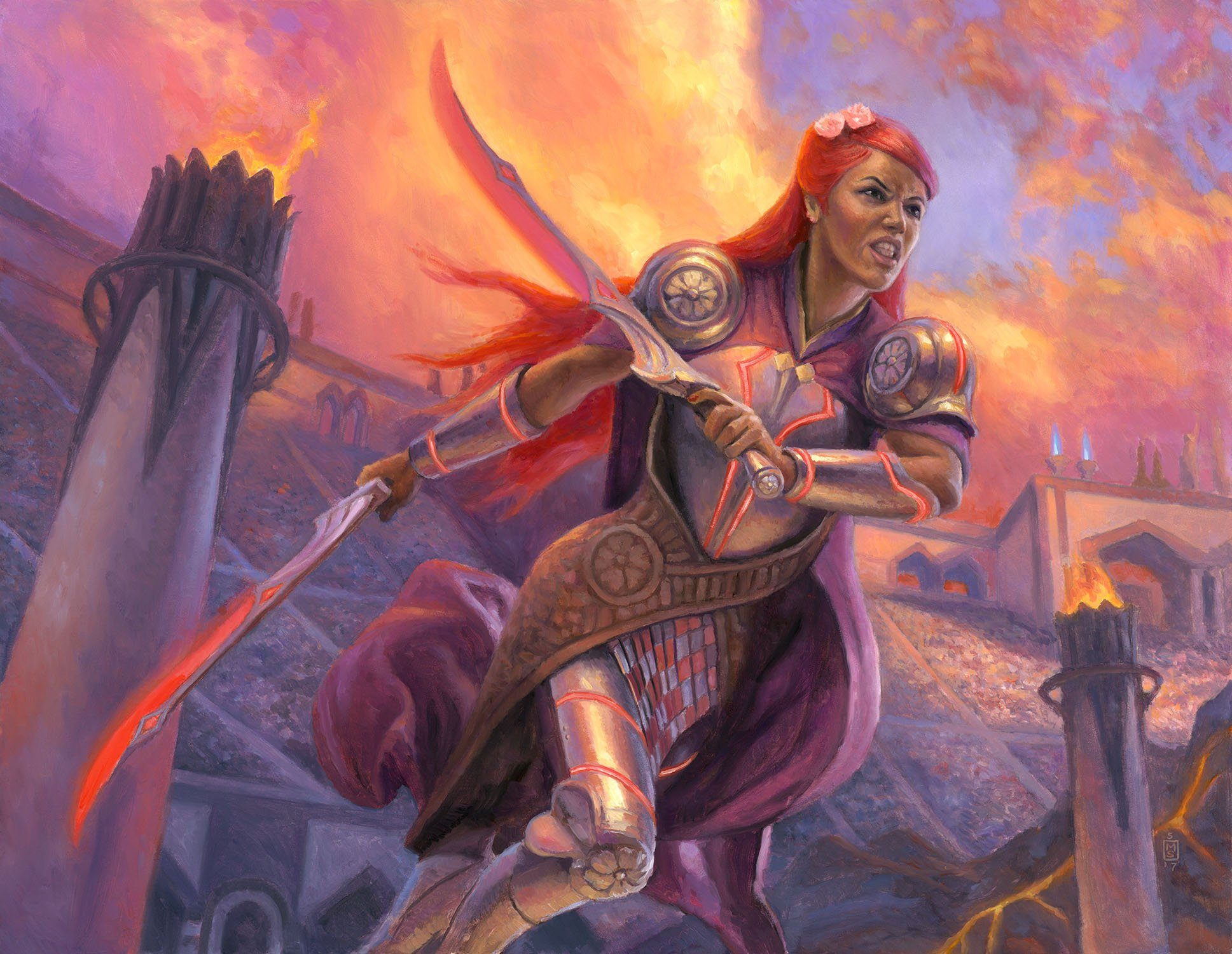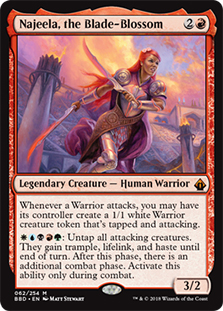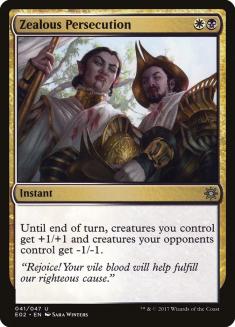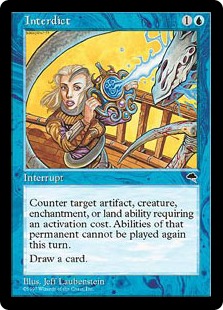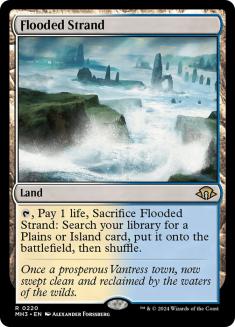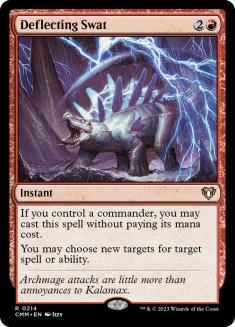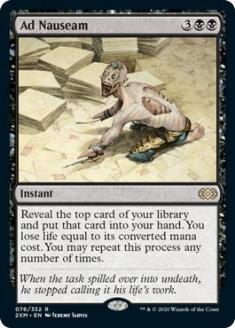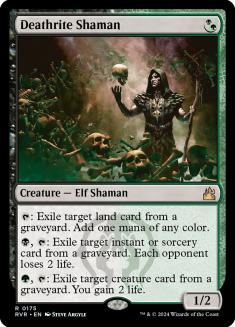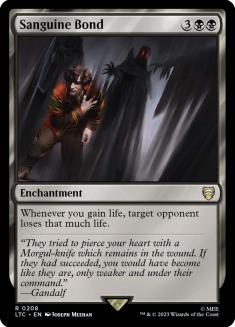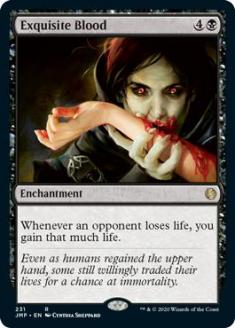2020 is already full of crazy, so when the nice folks from cEDH Brasil asked if I’d like to come on their stream, I figured it wouldn’t even rank in the top 100 wildest things that have happened this year. The Brazilian Magic scene is quite passionate, and I’m always up for hanging out with folks who truly love the game and the format. We agreed to play two webcam games: the first at the high-powered end, and the second representative of casual Commander—the core demographic if you will.
I went in with some preconceptions about the high-powered pool. I understood how much interaction would be at play. Someone described to me the difference between regular and cEDH: in one, it’s about the size of the battlefield; in the other, it’s about the size of the stack. I knew that while the game might take a while, the number of turns would be low. I expected that the game would end with an infinite combo that no one could stop because everyone else had stopped a first person from trying to go infinite. I won’t say that my expectations were completely upended, but they certainly weren’t exactly met, either.
I wanted to play a deck that got into the red zone. Because I’d be playing with people who know the ins and outs of environment far better than I would, aggression seemed better than control. Of course, you can’t play at this end without lots of interaction, so I had to make sure I kept up in that regard.
Because of all the interaction, I needed a Plan B (and maybe Plan C). I also needed a deck that didn’t have such a steep learning curve. I wouldn’t have the time to do hundreds or even dozens of goldfishes and certainly not enough time to get in the reps on playing the deck live. It’s not the kind of deck you just jam with your casual friends.
Here’s the list I came up with:
Creatures (18)
- 1 Llanowar Elves
- 1 Birds of Paradise
- 1 Gilded Drake
- 1 Elves of Deep Shadow
- 1 Dark Confidant
- 1 Aven Mindcensor
- 1 Vexing Shusher
- 1 Noble Hierarch
- 1 Arbor Elf
- 1 Avacyn's Pilgrim
- 1 Deathrite Shaman
- 1 Elvish Mystic
- 1 Derevi, Empyrial Tactician
- 1 Mindblade Render
- 1 Dockside Extortionist
- 1 Oakhame Adversary
- 1 Thassa's Oracle
- 1 Drannith Magistrate
Lands (30)
- 1 Forbidden Orchard
- 1 Forest
- 1 Wooded Foothills
- 1 City of Brass
- 1 Volcanic Island
- 1 Underground Sea
- 1 Tundra
- 1 Tropical Island
- 1 Taiga
- 1 Scrubland
- 1 Savannah
- 1 Bayou
- 1 Badlands
- 1 Windswept Heath
- 1 Polluted Delta
- 1 Bloodstained Mire
- 1 Snow-Covered Forest
- 1 Tarnished Citadel
- 1 Overgrown Tomb
- 1 Watery Grave
- 1 Breeding Pool
- 1 Hallowed Fountain
- 1 Exotic Orchard
- 1 Arid Mesa
- 1 Marsh Flats
- 1 Misty Rainforest
- 1 Scalding Tarn
- 1 Verdant Catacombs
- 1 Command Tower
- 1 Mana Confluence
Spells (51)
- 1 Brainstorm
- 1 Mana Drain
- 1 Vampiric Tutor
- 1 Mystical Tutor
- 1 Enlightened Tutor
- 1 Force of Will
- 1 Sylvan Library
- 1 Sol Ring
- 1 Demonic Tutor
- 1 Dark Ritual
- 1 Imperial Seal
- 1 Wild Growth
- 1 Red Elemental Blast
- 1 Mana Crypt
- 1 Nature's Will
- 1 Diabolic Intent
- 1 Plunge into Darkness
- 1 Lim-Dul's Vault
- 1 Pyroblast
- 1 Mystic Remora
- 1 Fire Covenant
- 1 Demonic Consultation
- 1 Interdict
- 1 Carpet of Flowers
- 1 Eladamri's Call
- 1 Rhystic Study
- 1 Tainted Pact
- 1 Lotus Petal
- 1 Chrome Mox
- 1 Utopia Sprawl
- 1 Delay
- 1 Pact of Negation
- 1 Ponder
- 1 Ad Nauseam
- 1 Zealous Persecution
- 1 Silence
- 1 Dispel
- 1 Preordain
- 1 Mental Misstep
- 1 Gitaxian Probe
- 1 Noxious Revival
- 1 Flusterstorm
- 1 Druids' Repository
- 1 Abrupt Decay
- 1 Cyclonic Rift
- 1 Swan Song
- 1 Eldritch Evolution
- 1 Assassin's Trophy
- 1 Dovin's Veto
- 1 Drown in the Loch
- 1 Fierce Guardianship

Those of you familiar with the high-powered end will see that the deck doesn’t break too much new ground. Najeela is a pretty popular option and I don’t feel like I have the expertise in the environment to make revolutionary choices. Brewing something unique from the ground up was out of the question, both due to the time commitment and my lack of sufficiently deep knowledge. Najeela felt like comfortable space.
The deck’s plan is relatively straightforward: eventual infinite combats with Najeela, or at least enough trips into the red zone to kill the table. That plan generally involves creating the necessary mana with Druids’ Repository (a card that seems pretty good even if it’s being used for purposes other than creating infinite loops). Sometimes, creating that mana comes from attacking with some of the mana-producing creatures and getting them untapped in order to be able to activate them.
At first glance I wondered why Najeela’s activated ability would need to give creatures haste in addition to trample and lifelink. If they’re already attacking, why would they require it? The answer came when I realized that the Warriors you create with the triggered ability need it to attack in subsequent combats, since they entered the battlefield tapped and attacking. I wonder if the designer realized that from the get-go or if it came up in playtesting.
Plan B is Thassa’s Oracle plus Demonic Consultation. A number of people who had seen the deck list said that if I played Demonic Consultation, the card I’d have to name is Lutri, the Spellchaser for the maximum amount of rub-ins. I wanted it to be Surgeon General Commander. By the MTR, you have to name a card legal in the format, so if the gang stuck to that, I’d have named Phelddagrif.
I made two kind of techy choices.
The first was Zealous Persecution. Zealous Persecution does some double duty. Primarily, it will kill off mana creatures (and a commander or two) of the opponents. If anyone has a deck reliant on them for mana (like mine is), it can be a huge blowout. This means that it’s not just an offensively minded card. It’s great when both the minuses to their creatures and pluses to yours are relevant, but sometimes you need to stop someone from going off, so playing Zealous Persecution on their turn is the right call.
The second part of killing off creatures is that it removes potential blockers. Najeela and friends need to stay alive in order to get value out of extra combats, so stuff not being in the way is optimal. Even if they live through Zealous Persecution, they’re smaller and yours are larger, meaning fewer bad combat matchups. With Najeela’s ability giving trample, you still get damage through. If you’re going infinite, the buff to your creatures isn’t consequential. In cases in which you’re not, the pump is a finishing move. Maybe you can only activate Najeela once or twice because you don’t have Druids’ Repository or Derevi, Empyrial Tactician. Life totals can get low as players use life as a resource. It might only take one or two attacks to knock out someone, even if you can’t take out the whole table.
The second outside-the-box choice was Interdict. It’s a Stifle variant (more correctly, Stifle is an Interdict variant, since Interdict came first) meant to shut down strategies that make repeated use of a permanent. Najeela would be one example. Another is Isochron Scepter, commonly imprinted with Dramatic Reversal. Sometimes, countering a single activated ability is enough, and Interdict gets there—although be warned it doesn’t work on planeswalkers, which weren’t yet invented when Interdict came out in Tempest.
The extra part of the equation is that Interdict draws a card, and sometimes you just need cards. I won’t argue that it’s more useful than Stifle, since Stifle can get planeswalker activations as well as triggered abilities, but I like the card draw utility. And I like doing things just a little differently.
The two cards I didn’t have lying around which I would have liked to put in were Flooded Strand and Deflecting Swat. Both are pretty straightforward. The fetchland potentially smooths out the mana, and in a game in which you’re not going to have that many lands on the battlefield, having the ones you need is critical. Because Najeela is so important to the primary gameplan, protecting her with things like Deflecting Swat is supremely important. As you’ll see, I would have really enjoyed Deflecting Swat.
The game in which I played demonstrated that it’s not always about the infinite combo. Since you can watch the replay, I won’t go into complete detail, but I’ll hit on a few major points. The game certainly lasted more turns than I expected it to, and non-infinite combat steps were far more significant than I thought they would be. In the end, my Najeela won the game—just not in the way I wanted it to.
I played with Deco (Korvold, Fae-Cursed King), Bispo (Jhoira, Weatherlight Captain), and Killstars (Thrasios & Kraum). We started with what was scheduled to be a brief interview, but we had such a good time chatting that it ran more than half an hour. Finally we got down to game time.
My first hand was landless, and even in a cEDH deck, that’s rarely good. My second seven wasn’t great, but playable: Misty Rainforest, Arbor Elf, Deathrite Shaman, a mana Elf, Dark Ritual, and two cards for later. I liked it most because of the Deathrite Shaman’s ability to give me any color of mana, knowing there’d be plenty of fetches to eat. What I didn’t realize was that DRS would become part of the long-term plan.
From my view, there were three critical moments in the game. One was Deco getting himself low enough in life from Ad Nauseam that Deathrite Shaman could (and did) kill him. He may have actually died to Mana Vault on his next upkeep, but there was no point in risking it, since the prize was sitting right in front of me.
It was about at that point when it looked like Deathrite Shaman draining away life might actually be a piece of the plan. That led to the second moment, in which I thought I could knock out Killstars with some combat damage via Zealous Persecution. He unfortunately had responses. The third major moment was Bispo taking Najeela with Gilded Drake. In the end, it’s what won him the game, as I was buried under an avalanche of tokens of my own indirect making.
I was enough of a factor in the game to enjoy myself (hey, I even got first blood), but my subsequent draws didn’t quite get me there; even Dark Confidant couldn’t much help. I used as many Deathrite Shaman activations as I could, and got folks low enough that a good combat could turn the tide, but alas, we fell short.
Getting one kill and nearly two was a better result than a beginner would expect, I think. It seemed necessary that Bispo and I team up to get rid of Killstars, who, in my estimation at least (later confirmed), was about to go off. I knew I was unlikely to come out on top heads up against Bispo, but you have to play to your outs, and not being dead is an out. I created a moment of tension by casting Silence, but it really was just for the drama; I knew I had no follow-through.
The only moment I questioned was if I should have played Silence before trying Zealous Persecution. ZP wasn’t really the game-ender that I wanted, and at that point was the only card of impact in my hand, so maybe it would have been right to protect it. Killstars later told me he could have countered both, but I was still left wondering if using it there would have been the percentage play.
The fact that two of the three kills came from combat damage of the non-infinite variety surprised me some. I went in imagining that there might be one, but then one of the combos would finish the game. Perhaps it was the decks we played, but things were well more midrangey than I expected. One of my preconceptions was that the game would just be a race to find the opening into which someone would fire all their rockets, there’d be a giant counter war, and we’d be done, but the pace was far more tentative than that.
The game demonstrated a kind of incrementalism that I didn’t expect. It was about setting up the combo haymakers, not just vomiting them onto the table. It was way more of a wrestling match than a bare-knuckled brawl. The possibility of the game going enough turns that repeated Deathrite Shaman activations might be a difference-maker was pretty much a foreign concept.
Here’s a thing that occurred to me. At this end of the format, you don’t play against cards; you play against decks. In core demographic Commander, you play against cards (which are in decks, obviously), but you’re really facing card synergies. If someone is playing Sanguine Bond, I need to prepare for Exquisite Blood, but I’m looking through a much smaller lens. In cEDH, you’re facing the whole thing all the time. Your knowledge has to be of the entirety of what the opponents are bringing to bear.
By chatting some with the experts, I realize that this primarily stems from who the commander is (“Thrasios/Kraum decks tend to do this; Najeela decks tend to do that”). It’s a necessarily different way of thinking about what you need to be thinking about. I was chatting with cobblepot about this idea, which he saw as an expansion of the battlefield VS stack metaphor. He said regular Commander “cares about points/nodes; cEDH cares about transitions between [them].” Solid analysis from a solid Magic mind.
While thought-provoking and compelling, it’s still not a style of play that resonates with me. Primarily, it’s an investment, and I don’t mean in dollars (although you can’t ignore that factor). It’s an investment in needing to understand the metagame, in knowing the intricate details of nearly every deck that you’re likely to face. It seems easier to me to know what 20,000 cards do than twelve decks. Those cards are static, while the decks are dynamic—and sometimes barely perceptibly so. It’s enjoyable, but not relaxing, and relaxation is what I want out of the Commander I play. I prefer being able to pay less attention to the details and more to the atmosphere and environment—but that’s really just a stylistic choice and not a commentary.
Thanks to the cEDH Brasil folks for having me. They have a great crew and a wonderful environment. We played two games (the second involved more casual decks, with Ruhan of the Fomori making an appearance), spanning some five hours, and it didn’t feel like we had gone that long. I’ll be happy to come back any time.
Visit my Decklist Database to see my Signature Decks, the Chromatic Project, and more!

